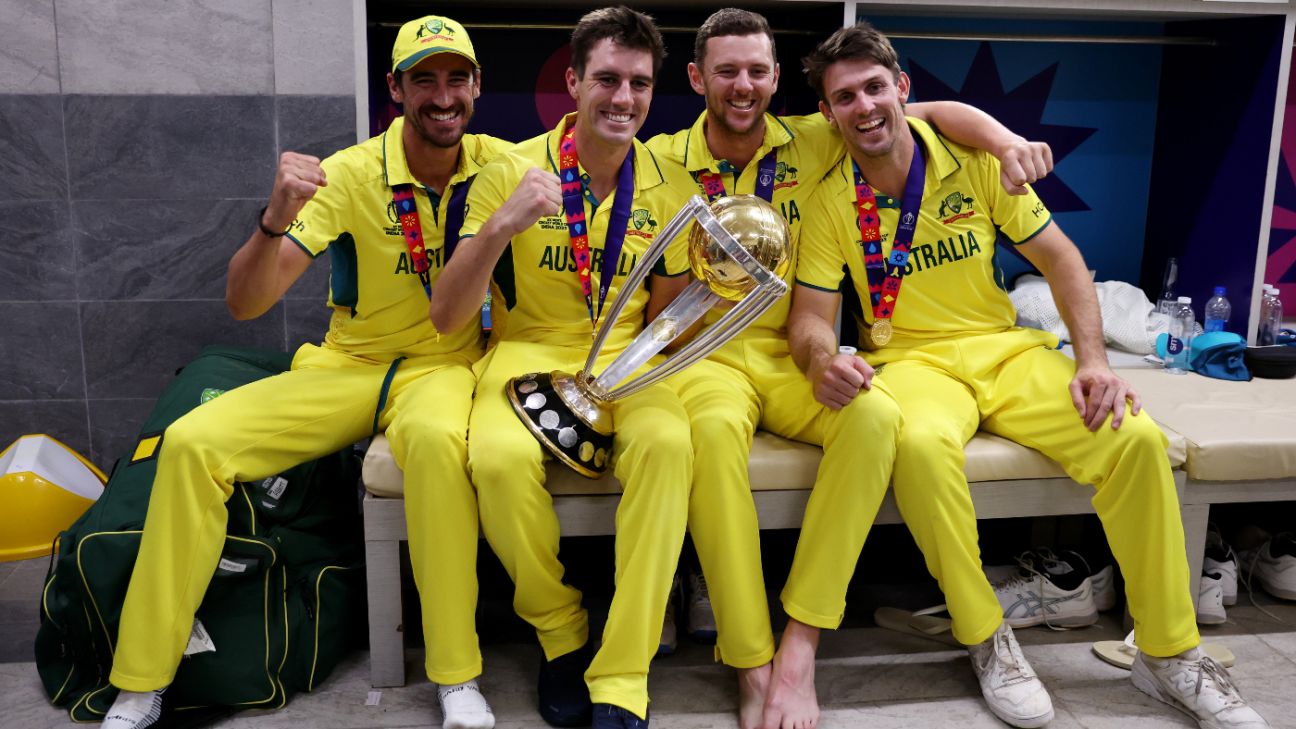They’ve been the lynchpins in Australia’s Test and ODI global titles, and every team will be fearful of what the triumvirate can do in T20Is
Melinda Farrell
Finch: Australia might need Ellis over Cummins due to England’s depth
Finch and Melinda Farrell preview their clash in Barbados
Cricket has always had iconic fast-bowling double-acts. Lillee and Thomson, Anderson and Broad, Wasim and Waqar, Marshall and Garner. There’s a particular thrill in watching a batter under the most fearsome examination from both ends. No respite, no way out. Sometimes the heat-wielding duo thrives with the red ball, sometimes with the white. Rarer and more precious are those who can intimidate with both.
But has there ever been a trio of quicks quite like Australia’s Big Three? You don’t even need to name them; we all know who they are.
There have been better, faster, more skilled individual bowlers. There have been more potent opening bowling partnerships. But three? In one team? In all three formats?
If Mitchell Marsh’s men are triumphant in the Caribbean, Australia will hold every ICC title apart from the Champions Trophy – that campaign must wait until next year. And central to their success are the Big Three, oh alright, Pat Cummins, Josh Hazlewood and Mitchell Starc.
They keep coming at you, opponents will say. See off Starc’s potent swing in one over and Hazlewood is there to nag away. Survive that and then try not to be blown away by Cummins’ pace or crafty cutters. A rotating carousel of pressure.
But this triumvirate did not emerge fully formed. In the early years of their respective careers, there were even doubts all three would ever play together. A mix of injury, rotation or suitability always kept one or the other out of any given side.
Starc’s prowess as a white-ball genius was never in doubt; his first ball to Brendon McCullum in the 2015 World Cup final dismissed any that might have existed. But some still felt he was too wayward or too expensive for Test cricket until his value, only heightened by the presence of his cartel bros, was truly understood.
Hazlewood, conversely, seemed a natural for Tests. His metronomic lines and length – gifts within that format – were considered a weakness in the shortest form, in which unpredictability and possession of a swag of variations were more enticing. But on the West Indies tour in 2021, he kickstarted a run of impressive performances, developed a few tricks, and found a way to shape his Test strengths into T20 weapons.
Cummins 1.0 was always injured and it was feared his first Test could be his last. There were a smattering of white-ball games in green and gold but it was only after the more durable Cummins 2.0 arrived in 2017 that he prospered as an all-format genius.
All three were there when Australia won the 2021 T20 World Cup in the UAE. They were there again in Ahmedabad last year when captain Cummins lifted the ODI World Cup. Hazlewood was left out of the XI that triumphed in the World Test Championship final at The Oval but his contributions in the series that led them there cannot be overlooked. And let’s not forget the bilateral victories they have collected along the way.
Between the 2022 T20 World Cup and the start of the current edition they have played just eight T20Is between them; Hazlewood four and two apiece for the others. Only once have all three bowled together in T20Is during that period, during Australia’s tour of New Zealand earlier this year.
While England have more clearly delineated their overall white and red-ball set-ups, from coach to captain to players, Australia have taken a more fluid approach. Nathan Ellis is one of several white-ball specialists to have played since the 2022 campaign, but there was never any doubt which three quicks would be first in that column for Mission ‘Caribbean 2024.’ And who needs succession planning when they can be brought in for the big show, not having to worry about those pesky bilaterals that don’t determine world champions.
Cummins was rested for Australia’s opening victory over Oman; they wanted him ‘cherry-ripe’ for the match against England. Instead, Ellis stepped in. His T20 repertoire of skiddy pace, deceptive slower balls and pinpoint yorkers at the death is highly respected by team-mates and opposition alike and has made a solid case for retention.
There’s a chance Ellis could play at Kensington Oval against England for the first time should conditions and match-ups align. A day out from the game that could have huge implications for Group B, Marsh all but confirmed Cummins’ selection. So if Ellis is in, it will be Hazlewood or Starc who drops out.
But if Australia find themselves needing to punch their way out of a corner in this tournament, the jab-jab-cross combination that has felled so many contenders stands ready, winning key moments on the biggest stage, whatever the format, now a muscle memory.
After all, who wouldn’t bring the band back together, when collectively they land the biggest hits.
Melinda Farrell is a journalist and broadcaster

